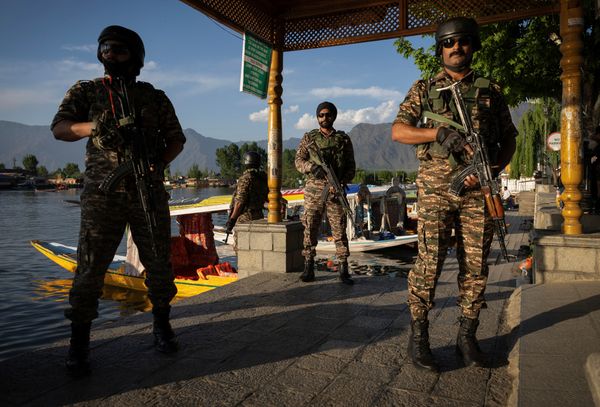
It’s been a brutal week in weather-related disasters across the US. Large parts of the south-east are still grappling with the devastation caused by Hurricane Helene, and another potentially catastrophic storm is barreling towards Florida. At the same time, much of the west has been sweltering amid scorching temperatures, which have elevated fire risks and fueled extreme fire behavior.
Hurricanes and fires aren’t abnormal in early autumn. But the climate crisis has turned up the dial and created more opportunities for catastrophes to overlap, ultimately adding strain on relief resources, emergency response, and those who have been impacted by the dangerous and destructive events.
While federal officials have been clear that emergency response agencies have been able to lead on recovery efforts following Hurricane Helene, strongly disputing rampant misinformation about misuse or politicization of the funds in areas devastated by the storm, the competing disasters nonetheless have severely strained the agencies.
The homeland security secretary, Alejandro Mayorkas, told reporters last week that Fema “does not have the funds to make it through the season”. Joe Biden echoed those concerns in a letter to Congress, calling on legislators to increase funding to ensure Fema won’t have to “forego longer-term recovery activities in favor of meeting urgent needs.
“The Congress should provide FEMA additional resources to avoid forcing that kind of unnecessary trade-off and to give the communities we serve the certainty of knowing that help will be ongoing, both for the short- and long-term,” the US president wrote.
Meanwhile, dangerous fire conditions in the west prompted officials to bump the country’s response to preparedness level 5 (PL5) on Tuesday, the highest level. The early-October designation – the latest PL5 since the system began registering the levels in 1990 – shows that resources for fighting fire are growing scarce as conditions linger into autumn.
It’s already been a busy season for firefighters, many who have logged up to 1,400 hours of overtime fighting blazes that have covered more than 7.6m acres in the US so far this year. Faced with dwindling budgets, the drawdown in seasonal crews, and deployment of more than a thousand wildfire personnel to aid in Helene recovery efforts, agencies are yet again scrambling.
In response, the National Multi-Agency Coordinating Group (NMAC), responsible for organizing the country’s fire suppression operations, called for plans for prescribed burns to be put on hold, potentially limiting how much mitigation work will be possible this autumn.
“Due to the unprecedented fire environment forecasted through mid-October, increased initial attack and growth on existing fires, competition for resources including a growing commitment of resources to Hurricane Helene, and the seasonal reduction in firefighting resources,” the agency wrote, “the NMAC urges extreme caution … in executing new prescribed fires in the current environment and would strongly caution against any reliance on national resources to achieve Rx objectives; new ignitions may pose a risk of escape due to current weather and fuels conditions which would further strain the availability of national resources.”
‘They all go hand in hand’
As the country cooks into the autumn months, stretching fire season longer and longer, the risks of devastating hurricanes climb.
“This is the normal time of year for hurricanes, but the Gulf of Mexico is so warm these storms get to be monsters really quickly,” said Dr Dave Easterling, senior climate scientist at the National Centers for Environmental Information (NCEI).
“Out west you have heatwaves, fire, drought – they all go hand in hand,” he added.
Meanwhile, Hurricane Milton rapidly intensified into a category 5 on Monday, as Florida prepares for what could be the biggest evacuation in seven years. The storm is surging toward population centers just weeks after Helene caused widespread destruction and became one of the deadliest hurricanes. More than 230 fatalities have been confirmed, a toll that’s only expected to rise.
Like fire season, the risks of catastrophic hurricanes could linger longer, adding complications to response and recovery, as warm temperatures stretch across more months of the year.
This year is already on track to rank among the hottest on record with a good chance at replacing 2023 at the top. Heat can be a deadly event all on its own, but it also sets the stage for destructive – and expensive – catastrophes. The US in 2023 logged 28 billion-dollar-disasters, an unprecedented number according to officials at NOAA, which called them “just the latest examples of the extremes we now face that will continue to worsen due to climate change”.
It’s not the first time disaster funding has become a concern. Costs associated with weather catastrophes are on the rise and even with boosts to the budget, agencies have struggled to keep up, according to Jonathan Sury, a senior staff associate at the national center for disaster preparedness at Columbia University.
“Even though there has been a lot more money going to Fema’s budget to respond to these things, the scale of these disasters has really been sucking that money up,” he said, noting the rising amount of repeated events like the back-to-back hurricane threat.
He has contributed to a product called the natural hazards index, which maps community vulnerability, and said it’s now much more common to see extreme events overlap or compound, hammering communities one after the other, and taxing emergency management, first responders, and affected communities.
Future planning, especially at the community level, will be essential to prepare for and adapt to the present threats that are only expected to worsen as the world warms.
“We know heat is coming and will get worse. Some parts of that we can’t stop but there are ways we can adapt our communities and livelihoods to better manage ourselves and our resources during future disasters,” he said.
In the meantime, Easterling has cautioned all to take imminent warnings seriously. In his community outside Asheville, North Carolina, the onslaught from Helene showered more than 17in (43cm) of rain in mere days. Neighbors, though, saw roughly double that. Friends barely escaped their home before it washed away in the floods, which broke records set in 1916.
“The bottom line is when you hear warnings, take them seriously,” he said. “We are not going to necessarily see more hurricanes in the future but when the sea surface temperatures are as warm as they are, especially in the Gulf, we are going to see more powerful ones.”







